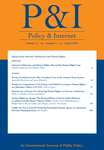Happy to announce the publication of a stellar special issue of the journal ‘Policy & Internet’, dedicated to ‘Internet Architecture & Human Rights’. The special issue, edited by DATACTIVE PI Stefania Milan with Monika Zalnieriute (Faculty of Law, UNSW Sydney, Australia), features articles by a number of key authors in the Internet governance field, such as Laura DeNardis and Samantha Brandshaw, Milton L. Mueller and Farzahen Badiei, Nicolas Suzor and colleagues, Ben Wagner, and our very own Niels ten Oever. Read it online!
Zalnieriute and Milan (2019). “Internet Architecture and Human Rights: Beyond the Human Rights Gap”, Policy & Internet, 11(1): 6-15, https://doi.org/10.1002/poi3.200
Internet architecture and infrastructure are generally not at the top of the concerns of end users, and the overlying logical arrangements of root services, domain names, and protocols remain largely invisible to its users. Recent developments, however—including massive user data leakages, hacks targeting social networking service providers, and behavioral micro‐targeting—have turned a spotlight on Internet governance defined broadly, and its relationship with civil liberties and human rights. The articles in this special issue examine the policymaking role of influential private intermediaries and private actors such as ICANN in enacting global governance via Internet architecture, exploring the implications of such a mode of governance for human rights. They consider: to what extent are human rights standards mediated and set via technical infrastructure, such as the DNS and platform policies, rather than by governmental structures? What are the implications of governance via Internet architecture for individual human rights? And what frameworks—be they legal, technological or policy‐related—are needed to address the contemporary privatization of human rights online, in order to ensure the effective protection of human rights in the digital age?
ten Oever (2019). “Productive Contestation, Civil Society, and Global Governance: Human Rights as a Boundary Object in ICANN”, Policy & Internet, 11(1): 37-60, https://doi.org/10.1002/poi3.172
Human rights have long been discussed in relation to global governance processes, but there has been disagreement about whether (and how) a consideration for human rights should be incorporated into the workings of the Internet Corporation for Assigned Names and Numbers (ICANN), one of the main bodies of Internet governance. Internet governance is generally regarded as a site of innovation in global governance; one in which civil society can, in theory, contribute equally with government and industry. This article uses the lens of boundary object theory to examine how civil society actors succeeded in inscribing human rights as a Core Value in ICANN’s bylaws. As a “boundary object” in the negotiations, the concept of human rights provided enough interpretive flexibility to translate to the social realities of the various stakeholder groups, including government and industry. This consensus‐building process was bound by the organizing structure of the boundary object (human rights), and its ability to accommodate the interests of the different parties. The presence of civil society at the negotiating table demanded a shift in strategy from the usual “outsider” tactics of issue framing and agenda setting, to a more complex and iterative process of “productive contestation,” a consensus‐building process fueled by the differences of experience and interests of parties, bound together by the organizing structure of the boundary object. This article describes how this process ultimately resulted in the successful adoption of human rights in ICANN’s bylaws.
Cite as Zalnieriute and Milan (eds.) (2019). Special issue ‘Internet Architecture & Human Rights’, Policy & Internet, 11(1)

